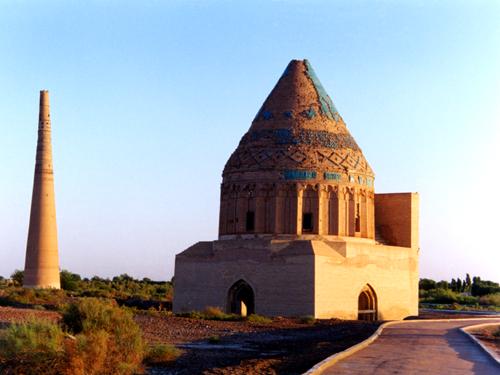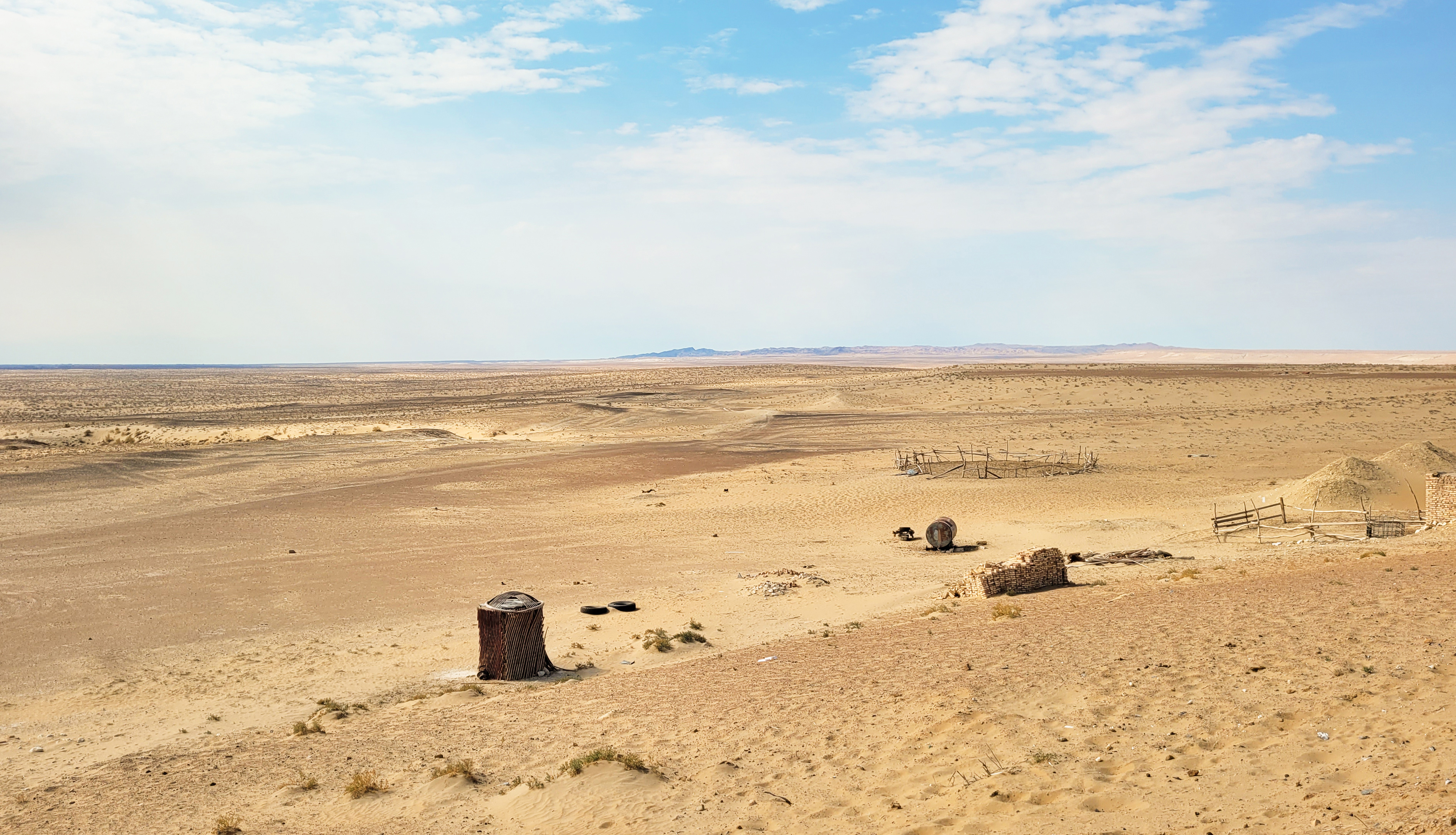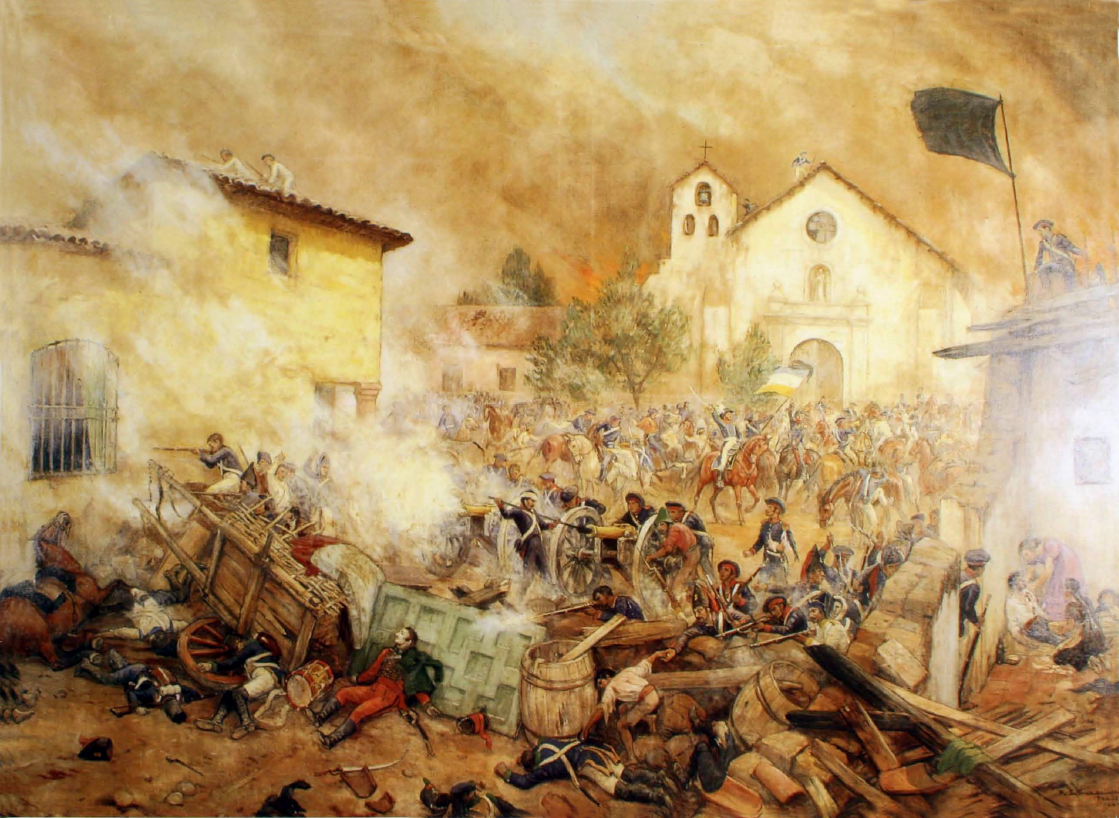|
Siege Of Samarkand (1220)
The siege of Samarkand (1220) took place in 1220 A.D. after Genghis Khan, founder of the Mongol Empire, had launched a multi-pronged invasion of the Khwarazmian Empire, ruled by Shah Muhammad II. The Mongols had laid siege to the border town of Otrar, but finding its defences obdurate, a large force commanded by Genghis and his youngest son Tolui detached from the vanguard and set off southwards, towards Transoxiana. Samarkand was the Shah's capital and the pivot of his defence — the city's garrison was large and its battlements were one of the strongest in the empire. Genghis, however, managed to isolate it by capturing and destroying Bukhara in a surprise manoeuvre, and then laying waste to the nearby Transoxianan towns. After repelling relief forces, the Mongol army, now reinforced after the capture of Otrar, ambushed and massacred a sortie by the town's defenders. The citizens of the city soon surrendered at the instigation of the Muslim clergy; most were however ensla ... [...More Info...] [...Related Items...] OR: [Wikipedia] [Google] [Baidu] [Amazon] |
Mongol Invasion Of The Khwarazmian Empire
Between 1219 and 1221, the Mongol Empire, Mongol forces under Genghis Khan invaded the lands of the Khwarazmian Empire in Central Asia. The campaign, which followed Mongol conquest of the Qara Khitai, the annexation of the Qara Khitai Khanate, saw Destruction under the Mongol Empire, widespread devastation and atrocities. The invasion marked the completion of the Mongol conquest of Central Asia, and began the Mongol conquest of Persia. Both belligerents, although large, had been formed recently: the Khwarazmian dynasty had expanded from Khwarazm, their homeland to replace the Seljuk Empire in the late 1100s and early 1200s; nearly simultaneously, Genghis Khan Rise of Genghis Khan, had unified the Mongolic peoples and conquered the Mongol conquest of Western Xia, Western Xia dynasty. Although relations were initially cordial, Genghis was angered by a series of diplomatic provocations. When a senior Mongol diplomat was executed by Khwarazmshah Muhammad II of Khwarazm, Muhammed I ... [...More Info...] [...Related Items...] OR: [Wikipedia] [Google] [Baidu] [Amazon] |
Muhammad II Of Khwarazm
'Alā' al-Din Muhammad II (Persian language, Persian: علاءالدین محمد خوارزمشاه; full name: ''Ala ad-Dunya wa ad-Din Abul-Fath Muhammad Sanjar ibn Tekish'') was the Shah of the Khwarazmian Empire from 3 August 1200 to 11 January 1221. His ancestor was Anushtegin Gharchai, a Turkic peoples, Turkic Ghilman, Ghulam who eventually became a viceroy of a small province in Central Asia named Khwarazm. He was subjected to the Mongol conquest of the Khwarazmian Empire, which resulted in the utter destruction of his empire. Reign After his father Ala ad-Din Tekish, Tekish died, Muhammad succeeded him. Right after his accession, however, his domains were invaded by the two Ghurid brothers Ghiyath al-Din Muhammad, Ghiyath al-Din Ghori and Mu'izz al-Din. Within weeks, the two brothers had moved their armies westwards into Greater Khorasan, Khorasan. Once they had captured Nishapur, Mu'izz al-Din was sent on an expedition towards Ray, Iran, Ray, but he let his troops get ou ... [...More Info...] [...Related Items...] OR: [Wikipedia] [Google] [Baidu] [Amazon] |
Kizil Kum
The Kyzylkum Desert (, قِیزِیلقُوم; , قىزىلقۇم) is the 15th largest desert in the world. Its name means ''Red Sand'' in Turkic languages. It is located in Central Asia, in the land between the confluent rivers Amu Darya and Syr Darya, a region historically known as Transoxania.Mapping Mongolia: Situating Mongolia in the World from Geologic Time to the Present, Paula L.W. Sabloff, P.62 Today it is divided among Kazakhstan, Turkmenistan and Uzbekistan. It covers about . Geography Kyzylkum is mainly located in Uzbekistan. Its territory consists mainly of an extensive plain at an altitude up to above sea level, with a number of depressions and highlands (Sultanuizdag, Bukantau). Most of the area is covered with dunes (barchans); in the northwest large areas are covered with takirs (clay coatings); there are also some oases. There are agricultural settlements along the rivers and in the oases. Temperatures can be very high during the summer months, from mid-Ma ... [...More Info...] [...Related Items...] OR: [Wikipedia] [Google] [Baidu] [Amazon] |
Military Engineers
Military engineering is loosely defined as the art, science, and practice of designing and building military works and maintaining lines of military transport and military communications. Military engineers are also responsible for logistics behind military tactics. Modern military engineering differs from civil engineering. In the 20th and 21st centuries, military engineering also includes CBRN defense and other engineering disciplines such as mechanical and electrical engineering techniques. According to NATO, "military engineering is that engineer activity undertaken, regardless of component or service, to shape the physical operating environment. Military engineering incorporates support to maneuver and to the force as a whole, including military engineering functions such as engineer support to force protection, counter improvised explosive devices, environmental protection, engineer intelligence and military search. Military engineering does not encompass the activities un ... [...More Info...] [...Related Items...] OR: [Wikipedia] [Google] [Baidu] [Amazon] |
Kangly
The Kangly (康曷利; pinyin: Kānghélì; Middle Chinese ( ZS): /kʰɑŋ-ɦɑt̚-liɪH/ or 康里 pinyin: ''Kānglĭ'' Historical references Kara-Khanid lexicographer Mahmud al-Kashgari mentioned a Kipchak chief surnamed ''Qanglı'' and simply glossed ''Qanglı'' as "a wagon for carrying load". Supposedly, they might be identified as or closely related to Kipchaks; or formed part of the Pechenegs, or were of Tiele origin. ''Gaoche'', Chinese exonomy for Tiele means "high cart". Byzantine Emperor Constantine VII mentions three Pecheneg tribes collectively known as the Kangar in his ''De Administrando Imperio''. ''Kangar'' is associated with Kang territory and probably with the Kangaris people and the city of Kangu Tarban, mentioned in the Kul Tigin inscription of the Orkhon Turkic peoples. Still, the relationship between the Kanglys, the Kangars, and the Kangaris / Kengeres (allies of the Eastern Turkic Khaganate against the Western Turkic Khaganate), is still unclear. ... [...More Info...] [...Related Items...] OR: [Wikipedia] [Google] [Baidu] [Amazon] |
Balkh
Balkh is a town in the Balkh Province of Afghanistan. It is located approximately to the northwest of the provincial capital city Mazar-i-Sharif and approximately to the south of the Amu Darya and the Afghanistan–Uzbekistan border. In 2021–2022, the National Statistics and Information Authority reported that the town had 138,594 residents. Listed as the List of cities in Afghanistan, eighth largest settlement in the country, unofficial 2024 estimates set its population at around 114,883 people. Historically, the site of present-day Balkh was held in considerably high regard due to its religious and political significance in Ariana. A hub of Zoroastrianism and Buddhism, the ancient city was also known to the Ancient Iran, Persians as Zariaspa and to the Ancient Greece, Greeks as Bactra, giving its name to Bactria. As such, it was famously known as the capital of Bactria or Tokharistan. The Italian explorer and writer Marco Polo described Balkh as "a noble city and a great ... [...More Info...] [...Related Items...] OR: [Wikipedia] [Google] [Baidu] [Amazon] |
Timurid Empire
The Timurid Empire was a late medieval, culturally Persianate, Turco-Mongol empire that dominated Greater Iran in the early 15th century, comprising modern-day Iran, Iraq, Afghanistan, much of Central Asia, the South Caucasus, and parts of contemporary Pakistan, North India, and Turkey. The empire was culturally hybrid, combining Turkic, Mongolic, and Persian influences, with the last members of the dynasty being regarded as "ideal Perso-Islamic rulers". The empire was founded by Timur (also known as Tamerlane), a warlord of Turco-Mongol lineage, who established the empire between 1370 and his death in 1405. He envisioned himself as the great restorer of the Mongol Empire of Genghis Khan, regarded himself as Genghis's heir, and associated closely with the Borjigin. Timur continued vigorous trade relations with Ming China and the Golden Horde, with Chinese diplomats like Ma Huan and Chen Cheng regularly traveling west to Samarkand to buy and sell goods. The empire led ... [...More Info...] [...Related Items...] OR: [Wikipedia] [Google] [Baidu] [Amazon] |
Pax Mongolica
The Pax Mongolica (Latin for "Mongol Peace"), less often known as Pax Tatarica ("Tatar Peace"), is a historiographical term modeled after the original phrase '' Pax Romana'' which describes the stabilizing effects of the conquests of the Mongol Empire on the social, cultural and economic life of the inhabitants of the vast Eurasian territory that the Mongols conquered in the 13th and 14th centuries. The term is used to describe the eased communication and commerce that the unified administration helped to create and the period of relative peace that followed the Mongols' vast and violent conquests. The conquests of Genghis Khan (r. 1206–1227) and his successors, spanning from Southeast Asia to Eastern Europe, effectively took over the Eastern world with the Western world. The Silk Road, connecting trade centres across Asia and Europe, came under the sole rule of the Mongol Empire. It was commonly said that "a maiden bearing a nugget of gold on her head could wander safely th ... [...More Info...] [...Related Items...] OR: [Wikipedia] [Google] [Baidu] [Amazon] |
Amu Darya
The Amu Darya ( ),() also shortened to Amu and historically known as the Oxus ( ), is a major river in Central Asia, which flows through Tajikistan, Turkmenistan, Uzbekistan, and Afghanistan. Rising in the Pamir Mountains, north of the Hindu Kush, the Amu Darya is formed by the confluence of the Vakhsh River, Vakhsh and Panj River, Panj rivers, in the Tigrovaya Balka Nature Reserve on the border between Afghanistan and Tajikistan, and flows from there north-westwards into the South Aral Sea, southern remnants of the Aral Sea. In its upper course, the river forms part of Afghanistan's northern border with Tajikistan, Uzbekistan, and Turkmenistan. In ancient history, the river was regarded as the boundary of Greater Iran with Turan, which roughly corresponded to present-day Central Asia.B. SpulerĀmū Daryā in Encyclopædia Iranica, online ed., 2009 The Amu Darya has a flow of about 70 cubic kilometres per year on average. Names In classical antiquity, the river was known as the ... [...More Info...] [...Related Items...] OR: [Wikipedia] [Google] [Baidu] [Amazon] |
Siege Of Otrar
A siege () . is a military blockade of a city, or fortress, with the intent of conquering by attrition, or by well-prepared assault. Siege warfare (also called siegecrafts or poliorcetics) is a form of constant, low-intensity conflict characterized by one party holding a strong, static, defensive position. Consequently, an opportunity for negotiation between combatants is common, as proximity and fluctuating advantage can encourage diplomacy. A siege occurs when an attacker encounters a city or fortress that cannot be easily taken by a quick assault, and which refuses to surrender (military), surrender. Sieges involve surrounding the target to block provision of supplies and reinforcement or escape of troops (a tactic known as "investment (military), investment"). This is typically coupled with attempts to reduce the fortifications by means of siege engines, artillery bombardment, mining (military), mining (also known as sapping), or the use of deception or treachery to bypass ... [...More Info...] [...Related Items...] OR: [Wikipedia] [Google] [Baidu] [Amazon] |
Bukhara
Bukhara ( ) is the List of cities in Uzbekistan, seventh-largest city in Uzbekistan by population, with 280,187 residents . It is the capital of Bukhara Region. People have inhabited the region around Bukhara for at least five millennia, and the city has existed for half that time. Located on the Silk Road, the city has long served as a center of trade, scholarship, culture, and religion. Bukhara served as the capital of the Khanate of Bukhara, Emirate of Bukhara and later Bukhara People’s Soviet Republic. It was the birthplace of the scholar Imam Bukhari. The city has been known as "Noble Bukhara" (''Bukhārā-ye sharīf''). Bukhara has about 140 architectural monuments. UNESCO has listed the historic center of Bukhara (which contains numerous mosques and madrasas) as a List of World Heritage Sites in Uzbekistan, World Heritage Site. Names The exact name of the city of Bukhara in ancient times is unknown. The whole Oasis of Bukhara, oasis was called Bukhara in ancient times, ... [...More Info...] [...Related Items...] OR: [Wikipedia] [Google] [Baidu] [Amazon] |
Siege Of Bukhara
The siege of Bukhara took place in February 1220, during the Mongol invasion of the Khwarazmian Empire. Genghis Khan, ruler of the Mongol Empire, had launched a multi-pronged assault on the Khwarazmian Empire ruled by Shah Muhammad II. While the Shah planned to defend his major cities individually, the Mongols laid siege to the border town of Otrar, and struck further into Khwarazmia. The city of Bukhara was a major centre of trade and culture in the Khwarazmian Empire, but was located far from the border with the Mongol Empire, and so the Shah had allocated fewer than 20,000 soldiers to defend it. A Mongol force, estimated to number between 30,000 and 50,000 men and commanded by Genghis himself, traversed the Kyzylkum Desert, previously considered impassable for large armies. Bukhara's defenders were caught by surprise and, after a failed sortie, the outer city surrendered within three days on 10 February. Khwarazmian loyalists continued to defend the citadel for less th ... [...More Info...] [...Related Items...] OR: [Wikipedia] [Google] [Baidu] [Amazon] |








